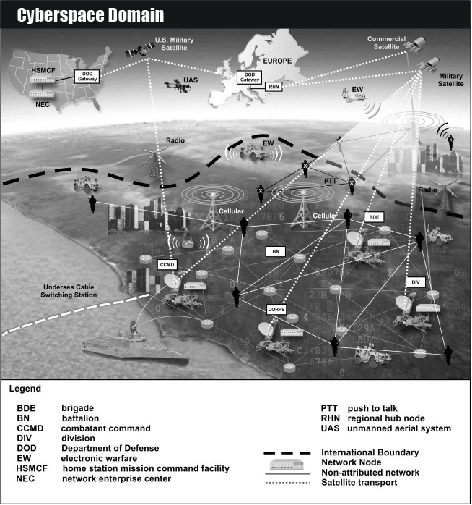Cyberspace is a global domain within the information environment consisting of the interdependent networks of information technology infrastructures and resident data, including the Internet, telecommunications networks, computer systems, and embedded processors and controllers. A cyberspace capability is a device, computer program, or technique, including any combination of software, firmware, or hardware, designed to create an effect in or through cyberspace. Friendly, enemy, adversary, and host nation networks, communications systems, computers, cellular phone systems, social media Web sites, and technical infrastructures are all part of cyberspace.
Cyberspace operations are the employment of cyberspace capabilities where the primary purpose is to achieve objectives in or through cyberspace (JP 3-0). The interrelated cyberspace missions are DODIN operations, DCO, and OCO. The Army performs cyberspace operations and supporting activities within this domain as part of joint and Army operations.
Cyberspace and the electromagnetic spectrum (EMS) are essential for Army operations and are inherently joint, interorganizational, multinational, and commercial. All Army operations, missions, activities, and functions use cyberspace. Cyberspace superiority is the degree of dominance in cyberspace by one force that permits the secure, reliable conduct of operations by that force, and its related land, air, maritime, and space forces at a given time and place without prohibitive interference by an enemy or adversary (JP 3-12). Cyberspace superiority enables, supports, provides, and facilitates warfighting capabilities that affect, support, and enable every warfighting function and daily activity.
Although cyberspace coexists with the other domains, it is a separate domain. Cyberspace pervades the land, air, maritime, and space domains through the EMS and wired networks. Cyberspace enables integration across physical domains by moving data along transmission paths through links and nodes in cyberspace and the EMS. The man-made aspects of cyberspace, coupled with continual advances in technologies, contribute to a continuous obligation to manage risk and protect portions of cyberspace.
Cyberspace enables and enhances the ability of commanders to perform mission command. The DODIN is the DOD’s portion of cyberspace and is distinct in that it provides the medium for communication among the forces within other operational domains. The Department of Defense information network is the set of information capabilities, and associated processes to collect, process, store, disseminate, and manage information on demand to warfighters, policy makers, and support personnel, whether interconnected or stand-alone, including owned and leased communications and computing systems and services, software (including applications), data, security services, other associated services, and national security systems (JP 6-0). The DODIN includes all DOD information technologies broadly grouped as DOD information systems, platform information technology, information technology services, and information technology products.
The Army uses the cyberspace domain every day to communicate, store data, plan missions, and perform tasks. In today’s dynamic operational environment, the exercise of mission command depends on freedom of maneuver within the cyberspace domain.
 This article is an extract from “CYBER1: The Cyberspace Operations & Electronic Warfare SMARTbook (Multi-Domain Guide to Offensive/Defensive CEMA and CO)” by The Lightning Press. Download a free PDF sample and learn more at: CYBER1: The Cyberspace Operations & Electronic Warfare SMARTbook.
This article is an extract from “CYBER1: The Cyberspace Operations & Electronic Warfare SMARTbook (Multi-Domain Guide to Offensive/Defensive CEMA and CO)” by The Lightning Press. Download a free PDF sample and learn more at: CYBER1: The Cyberspace Operations & Electronic Warfare SMARTbook.
Browse additional military doctrine articles in our SMARTnews Blog & Resource Center.
About The Lightning Press SMARTbooks. Recognized as a “whole of government” doctrinal reference standard by military, national security and government professionals around the world, SMARTbooks comprise a comprehensive professional library. SMARTbooks can be used as quick reference guides during operations, as study guides at education and professional development courses, and as lesson plans and checklists in support of training. Browse our collection of Military Reference SMARTbooks to learn more.














































